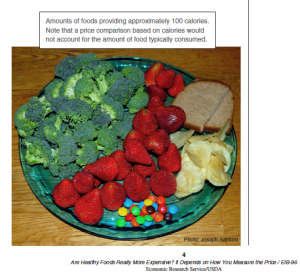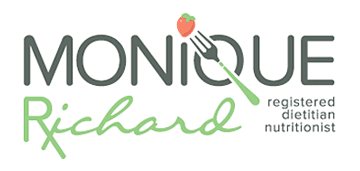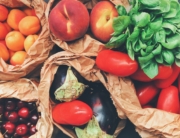
Healthy Food: More bang for your buck!
Today I’m devoting some time to do a bit of myth busting about the cost of healthy eating. You’ve probably frequently heard that eating well is expensive. Plant-based, vegetarian and Mediterranean style diets can be perceived as pricey and out of reach. Media, advertisements, and news articles often make the argument that heavily processed “junk” food is cheaper than healthy, nutritious foods, like fresh vegetables, fruit, and whole grains.
When you’re on a budget, the “high cost of healthy” concept can inadvertently become a great excuse to grab that fast food meal or a bag of chips instead of cooking at home or seeking out a fresher, more nutritious option. That’s why I want to debunk this myth once and for all, and share some great news with you:
You CAN eat healthy and well, ON A BUDGET!
The past several years we’ve seen some great research and reporting highlighting the fact that a diet made up of fresh veggies, fruits, low fat dairy, healthy oils, and whole grains is affordable– even on the USDA calculated lowest cost, thrifty meal plan (up to $150/week for a family of 4, or $40 for a single adult).
Part of the disconnect surrounding the cost of healthy eating lies in how you measure the cost: Measuring the cost of food on the basis of edible weight* and average portion size is much different than measuring the cost of food in terms of price per calorie. If you want to realistically measure the cost of food, it hardly makes sense to do it using calories–we eat in portions/meals, not in calories:
Think about how easy it is to eat a 600 calorie serving of fries or potato chips–in reality this is not a large amount of food, and it won’t suffice as a meal nutritionally–you likely would still be able to comfortably go on to eat an entire lunch or dinner. Yet eating those same 600 calories in the form of a meal made up of, for example, black beans, salsa, brown rice, veggies, and tortillas will fill your stomach and be full of fiber, antioxidants, vitamins and minerals.
Energy-dense, or high calorie, “junk” food like cookies, chips, and soda therefore sneakily seem cheaper than fruits and veggies, since their cost gets divided by a large number of calories. A great way this can be understood is comparing the cost of a gallon of skim vs. whole milk. Both types of milk have nearly identical retail costs, but since skim milk has about half the calories as whole milk, if we were to calculate its cost in terms of price per calorie, we would conclude that skim milk is twice as expensive as whole milk calorie for calorie!
A 2012 USDA report that analyzed and compared the costs of nearly 4,500 food items by price per calorie, per edible weight, and per average portion consumed found that:
“When measured on the basis of edible weight or average portion size, grains, vegetables, fruit, and dairy foods are less expensive than most protein foods and foods high in saturated fat, added sugars, and/or sodium.”
Similarly a recent study concluded that a plant-based, Mediterranean-style diet rich in extra virgin olive oil not only costs less per week than a USDA-approved, low cost, MyPlate-conforming meal plan, but also contained more fruits, veggies, and whole grains!
Look for upcoming blog posts on budget-friendly tips when cooking at home, like buying in bulk. You can get great cost savings buying food items like grains, frozen fruit and veggies, and nuts in seeds in quantity at wholesale prices. Check out your local health food store for “bulk bins” or consider a membership to a wholesale club like Costco or Sam’s Club.
Plus, check out Leanne Brown’s amazing (and free!) cookbook designed for eating healthy on $4/day, and Linda Watson’s Wildly Affordable $5/day organic food cookbook.
*edible weight is the price of preparing a given weight of a food item for consumption. It excludes weight of bones, skins, seeds, and shells.
Post a comment:
Or to schedule an appointment, click here.
This was a guest post by Eliza Mellion, Graduate Student in Nutrition at UMass Amherst.









